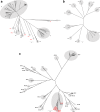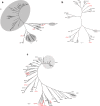Updated classification of norovirus genogroups and genotypes
- PMID: 31483239
- PMCID: PMC7011714
- DOI: 10.1099/jgv.0.001318
Updated classification of norovirus genogroups and genotypes
Erratum in
-
Corrigendum: Updated classification of norovirus genogroups and genotypes.J Gen Virol. 2020 Aug;101(8):893. doi: 10.1099/jgv.0.001475. J Gen Virol. 2020. PMID: 32854814 Free PMC article. No abstract available.
Abstract
Noroviruses are genetically diverse RNA viruses associated with acute gastroenteritis in mammalian hosts. Phylogenetically, they can be segregated into different genogroups as well as P (polymerase)-groups and further into genotypes and P-types based on amino acid diversity of the complete VP1 gene and nucleotide diversity of the RNA-dependent RNA polymerase (RdRp) region of ORF1, respectively. In recent years, several new noroviruses have been reported that warrant an update of the existing classification scheme. Using previously described 2× standard deviation (sd) criteria to group sequences into separate clusters, we expanded the number of genogroups to 10 (GI-GX) and the number of genotypes to 48 (9 GI, 27 GII, 3 GIII, 2 GIV, 2 GV, 2 GVI and 1 genotype each for GVII, GVIII, GIX [formerly GII.15] and GX). Viruses for which currently only one sequence is available in public databases were classified into tentative new genogroups (GNA1 and GNA2) and genotypes (GII.NA1, GII.NA2 and GIV.NA1) with their definitive assignment awaiting additional related sequences. Based on nucleotide diversity in the RdRp region, noroviruses can be divided into 60 P-types (14 GI, 37 GII, 2 GIII, 1 GIV, 2 GV, 2 GVI, 1 GVII and 1 GX), 2 tentative P-groups and 14 tentative P-types. Future classification and nomenclature updates will be based on complete genome sequences and will be coordinated and disseminated by the international norovirus classification-working group.
Keywords: 2xSD criteria; Norovirus; P-group; P-type; acute gastroenteritis; classification; genogroup; genotype.
Conflict of interest statement
The authors declare that there are no conflicts of interest.
Figures





References
-
- Green K. Caliciviridae: The noroviruses. In: Knipe DM, Howley PM, editors. Fields virology. Philadelphia, PA: Lippincott Williams & Wilkins; 2013. pp. 586–608.
Publication types
MeSH terms
LinkOut - more resources
Full Text Sources
Other Literature Sources
Medical
Research Materials

